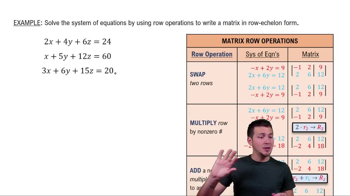Table of contents
- 0. Review of Algebra4h 16m
- 1. Equations & Inequalities3h 18m
- 2. Graphs of Equations43m
- 3. Functions2h 17m
- 4. Polynomial Functions1h 44m
- 5. Rational Functions1h 23m
- 6. Exponential & Logarithmic Functions2h 28m
- 7. Systems of Equations & Matrices4h 6m
- 8. Conic Sections2h 23m
- 9. Sequences, Series, & Induction1h 19m
- 10. Combinatorics & Probability1h 45m
7. Systems of Equations & Matrices
Introduction to Matrices
Problem 63
Textbook Question
Find each product, if possible. See Examples 5–7. <4x2 Matrix>
 Verified step by step guidance
Verified step by step guidance1
<Step 1: Understand the problem. We need to find the product of a 4x2 matrix with another matrix. To multiply matrices, the number of columns in the first matrix must equal the number of rows in the second matrix.>
<Step 2: Identify the dimensions of the matrices. The given matrix is a 4x2 matrix, which means it has 4 rows and 2 columns.>
<Step 3: Determine the dimensions of the second matrix. To multiply with a 4x2 matrix, the second matrix must have 2 rows. The resulting product will have dimensions based on the outer dimensions of the matrices being multiplied.>
<Step 4: Set up the multiplication. If the second matrix is a 2xN matrix, the resulting product will be a 4xN matrix. Each element in the resulting matrix is found by taking the dot product of the corresponding row from the first matrix and the column from the second matrix.>
<Step 5: Perform the matrix multiplication. For each element in the resulting matrix, multiply corresponding elements from the row of the first matrix and the column of the second matrix, then sum these products.>
Recommended similar problem, with video answer:
 Verified Solution
Verified SolutionThis video solution was recommended by our tutors as helpful for the problem above
Video duration:
1mPlay a video:
Was this helpful?
Key Concepts
Here are the essential concepts you must grasp in order to answer the question correctly.
Matrix Multiplication
Matrix multiplication involves taking two matrices and producing a new matrix by multiplying rows of the first matrix by columns of the second. The number of columns in the first matrix must equal the number of rows in the second matrix for multiplication to be possible. The resulting matrix's dimensions are determined by the number of rows from the first matrix and the number of columns from the second.
Recommended video:

Finding Zeros & Their Multiplicity
Dimensions of a Matrix
The dimensions of a matrix are defined by the number of rows and columns it contains, expressed as 'm x n' where 'm' is the number of rows and 'n' is the number of columns. Understanding the dimensions is crucial for determining compatibility for operations like addition and multiplication, as these operations have specific requirements regarding the sizes of the matrices involved.
Recommended video:
Guided course

Introduction to Matrices
Product of Matrices
The product of two matrices is a new matrix formed by the multiplication of the two original matrices. Each element in the resulting matrix is calculated as the sum of the products of corresponding elements from the rows of the first matrix and the columns of the second. This operation is fundamental in linear algebra and has applications in various fields, including computer graphics and systems of equations.
Recommended video:
Guided course

Introduction to Matrices

 4:35m
4:35mWatch next
Master Introduction to Matrices with a bite sized video explanation from Patrick Ford
Start learningRelated Videos
Related Practice










